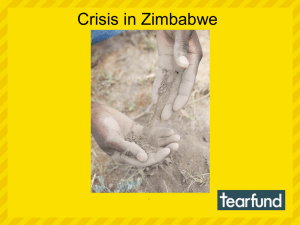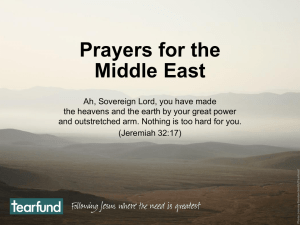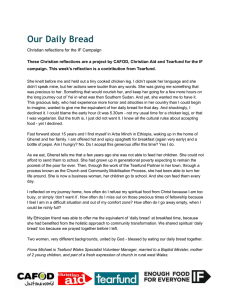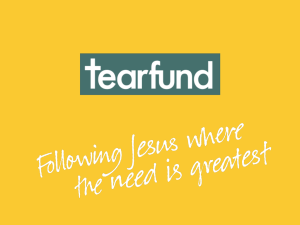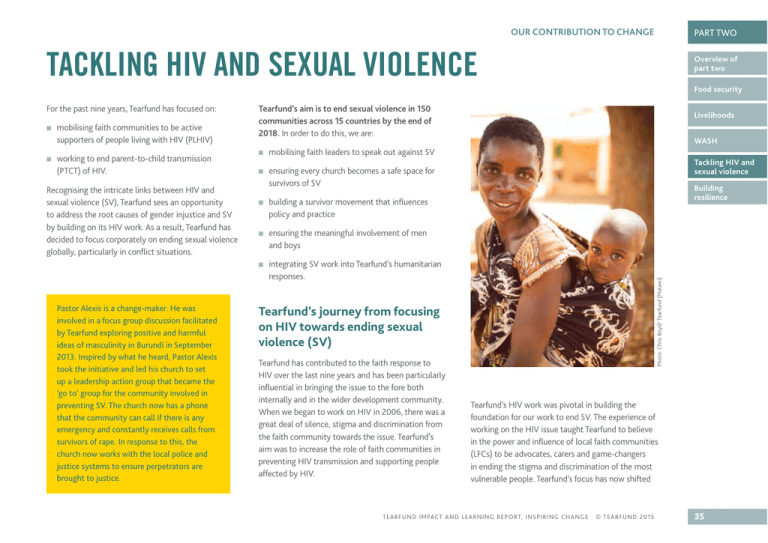
OUR CONTRIBUTION TO CHANGE
PART TWO
TACKLING HIV AND SEXUAL VIOLENCE
Overview of
part two
Food security
■
■
mobilising faith communities to be active
supporters of people living with HIV (PLHIV)
working to end parent-to-child transmission
(PTCT) of HIV.
Recognising the intricate links between HIV and
sexual violence (SV), Tearfund sees an opportunity
to address the root causes of gender injustice and SV
by building on its HIV work. As a result, Tearfund has
decided to focus corporately on ending sexual violence
globally, particularly in conflict situations.
Tearfund’s aim is to end sexual violence in 150
communities across 15 countries by the end of
2018. In order to do this, we are:
■
■
■
■
■
Pastor Alexis is a change-maker. He was
involved in a focus group discussion facilitated
by Tearfund exploring positive and harmful
ideas of masculinity in Burundi in September
2013. Inspired by what he heard, Pastor Alexis
took the initiative and led his church to set
up a leadership action group that became the
‘go to’ group for the community involved in
preventing SV. The church now has a phone
that the community can call if there is any
emergency and constantly receives calls from
survivors of rape. In response to this, the
church now works with the local police and
justice systems to ensure perpetrators are
brought to justice.
Livelihoods
WASH
mobilising faith leaders to speak out against SV
Tackling HIV and
sexual violence
ensuring every church becomes a safe space for
survivors of SV
Building
resilience
building a survivor movement that influences
policy and practice
ensuring the meaningful involvement of men
and boys
integrating SV work into Tearfund’s humanitarian
responses.
Photo: Chris Boyd/ Tearfund (Malawi)
For the past nine years, Tearfund has focused on:
Tearfund’s journey from focusing
on HIV towards ending sexual
violence (SV)
Tearfund has contributed to the faith response to
HIV over the last nine years and has been particularly
influential in bringing the issue to the fore both
internally and in the wider development community.
When we began to work on HIV in 2006, there was a
great deal of silence, stigma and discrimination from
the faith community towards the issue. Tearfund’s
aim was to increase the role of faith communities in
preventing HIV transmission and supporting people
affected by HIV.
Tearfund’s HIV work was pivotal in building the
foundation for our work to end SV. The experience of
working on the HIV issue taught Tearfund to believe
in the power and influence of local faith communities
(LFCs) to be advocates, carers and game-changers
in ending the stigma and discrimination of the most
vulnerable people. Tearfund’s focus has now shifted
T EA R FUND I M PACT A ND L E AR NI N G R E P O RT, I N SP I R IN G C H AN GE
© T E AR FU N D 201 5
35
PART TWO
Overview of
part two
Food security
Livelihoods
WASH
Tackling HIV and
sexual violence
Building
resilience
OUR CONTRIBUTION TO CHANGE
Working in partnership
towards ending SV, but key aspects of the HIV work
are being integrated into the ongoing SV strategy
where appropriate and important learning is being
applied.
Tearfund works in partnership with other agencies
and institutions as we know that a collaborative
effort will create greater change. In 2011, Tearfund
initiated and now chairs We Will Speak Out (WWSO),
a global coalition of Christian-based NGOs, churches
and organisations, supported by an alliance of
technical partners and individuals (including the
UN) who are committed to seeing an end to SV in
communities around the world. WWSO works to
empower women and girls, to transform relationships
between women and men, and to ensure that the
voices of survivors of SV – women, girls, men and
boys – are central to its work.
The HIV movement brought LFCs to the main
stage in international development, opening doors
and opportunities for meaningful partnerships as
demonstrated in UN commitments to working
with LFCs. This experience created tremendous
opportunities for faith leadership in preventing and
ending SV, which Tearfund has been instrumental in
facilitating and leading.
As a result of Tearfund’s work, we have seen babies
born free of HIV in communities where this would
have been unimaginable less than a decade ago. We
have seen survivors of sexual violence speak of their
dreams with confident voices. We have seen faith
leaders advise governments and demonstrate gender
justice in their own contexts, and we have seen
churches speak out for peace.
Key highlights
Photo: Eleanor Bentall/Tearfund (Rwanda)
■
36
T E A RF U ND IMPACT AND LEARN ING REPORT, I NSPI R ING CHA NGE
Mobilising men
A key aspect of both the HIV and SV responses
has been the focus on mobilising men and boys to
become active participants in understanding the
importance of women accessing antenatal services
and HIV treatments and supporting their partners
to do this. Another key focus has been changing
certain attitudes towards rape and violence against
© T EA R FUND 20 15
women and girls by addressing harmful practices
through group discussions and mentoring. In 2014,
Tearfund supported 801 men and boys to become
‘change-makers’ in tackling SV.
■
Investment in demonstrating evidence
of impact
Tearfund is committed to gathering evidence
of impact in its work to address HIV and end
SV using new technologies and processes that
enable us to articulate change. Tearfund’s MiHope
initiative (using mobile phones for information
and data collection) is a key example; in Malawi,
this method was used to demonstrate the impact
of a Mother Buddies scheme on PLHIV (see case
study on page 37).
■
Building strategic partners and allies
Tearfund’s investment in quality research and
gathering evidence has opened up opportunities
for building partnerships across organisations
and groups. Tearfund currently co-chairs the
Joint Learning Initiative SGBV Hub, and has
actively built partnerships across the UN, key
international development actors, DFID and
other donors. Our contribution to leading the
We Will Speak Out coalition is another example
of the interconnectedness of our work with
other agencies. To date, Tearfund has received
funding from and is involved with eight strategic
partners globally.
OUR CONTRIBUTION TO CHANGE
Supporting pregnant women
living with HIV through a Mother
Buddies scheme in Malawi
An impact assessment of a Tearfund programme to
support pregnant women living with HIV in Malawi
was undertaken in 2014, the results of which provide
evidence of our contribution to very positive changes
in the lives of the participants.
information, appointment reminders and an instant
messaging service.
Mother Buddies supported vulnerable pregnant
women at greatest risk of maternal and infant
mortality in rural communities. Women were visited
by Mother Buddies before, during and after their
pregnancy, supported by an innovative mobile phone
system called MiHope (Mobile Interactions Bringing
Hope) which guided them through the visits, providing
■
Clients achieving more than four antenatal
care visits
One of the primary objectives in reducing the risk
of HIV transmission was to ensure that vulnerable
women could access good antenatal care, and in
particular achieve the WHO standard of at least
four visits. Clients attended more antenatal visits,
and a higher proportion attended four or more
visits during their most recent pregnancy (61 per
cent compared with 44 per cent).
■
Male involvement
The programme embraced the principle that male
involvement is key to reducing transmission of
HIV; it was therefore encouraging to find that 69
per cent of women supported by Mother Buddies
were accompanied to antenatal care by their
partners, higher than the 54 per cent among the
control group.
The results are summarised below:
■
Family planning
A higher proportion of women supported by
Mother Buddies had received counselling on
family planning (82 per cent compared with 61 per
cent), and a higher proportion were using modern
methods of contraception (61 per cent compared
with 50 per cent).
The research compared a range of indicators between
two groups of women – those who had received
support from Mother Buddies (clients), and a control
group of similar women who had not received
support. The indicators focused on key determinants
of maternal and newborn health, and factors ensuring
that all children born to mothers living with HIV are
born HIV-free.
The main objective of the programme was to reduce
vertical transmission of HIV in order to contribute
to a reduction in maternal and infant mortality. The
programme mobilised churches and communities
to engage in a comprehensive approach to reducing
parent-to-child transmission (PTCT) of HIV and
improving maternal and infant health.
Central to the programme design was the training
of a network of community-based volunteers called
Mother Buddies. Mother Buddies were trained by
Tearfund and associated experts in Malawi in key
aspects of HIV and maternal and infant health.
■
Overview of
part two
Food security
Livelihoods
WASH
Tackling HIV and
sexual violence
Building
resilience
Delivery care
Recent births were almost entirely delivered in
health facilities by health professionals, but women
supported by Mother Buddies appeared to have
secured higher-quality delivery arrangements.
There has been a dramatic increase in the
preparation of birth plans over the duration of
the programme, from five per cent to 67 per cent,
although this was similar when compared to the
control group, of whom 72 per cent had birth plans,
indicating that this change cannot be attributed
solely to the Mother Buddies scheme.
Photo: Eleanor Bentall/Tearfund (Rwanda)
Cаe
S"#
PART TWO
T EA R FUND I M PACT A ND L E AR NI N G R E P O RT, I N SP I R IN G C H AN GE
© T E AR FU N D 201 5
37
OUR CONTRIBUTION TO CHANGE
Overview of
part two
■
Good nutrition during the first 1,000 days of a
child’s life is key to reducing health risks. Clients
were more likely to have at least three meals a
day (62 per cent compared with 44 per cent), and
had less difficulty meeting the food needs of the
household. Among all households, the proportion
of households who had at least three meals a day
increased from 34 per cent at baseline to 48 per
cent at end line. This is consistent with practical
support provided by Mother Buddies during both
their most recent pregnancy, and the six months
following their latest pregnancy, when they helped
with caring for the family, food, transport and
hygiene (especially after the birth).
Food security
Livelihoods
WASH
Tackling HIV and
sexual violence
Building
resilience
■
The data points to key trends on transmission
and access to treatment
By the end line, almost all mothers living with
HIV had been reached with advice about parentto-child transmission, almost all women with HIV
were accessing treatment (a 50 per cent increase
on baseline figures), and early infant diagnosis had
increased by 45 per cent from baseline figures.
Data also suggests that the proportion of children
born with HIV (to mothers living with HIV) has
halved; although the differences between the two
groups were not significant, this is encouraging as it
supports the key objective of the initiative to halve
the vertical transmission rate of HIV.
38
K!
L"#$
Practical support and nutrition
T E A RF U ND IMPACT AND LEARN ING REPORT, I NSPI R ING CHA NGE
A response shaped by a real
understanding of the most
vulnerable people
✓
Inclusion and accompaniment of the most
vulnerable and affected people across
communities ie HIV champions and SV
survivors is at the heart of our strategy to
tackle HIV and SV. Mentoring people to
become spokespersons in places of influence
has brought authenticity and integrity to
Tearfund’s work. This has ensured that
Tearfund’s strategy is most relevant to the
people we seek to serve.
✓
✓
Need for an adaptive and
entrepreneurial approach
Tearfund took the initiative to speak out when
it was risky; in general, the faith community did
not want to speak about HIV in 2006 when our
work began, and the development world was
uncomfortable with ‘faith’-based organisations.
However, by showing we are committed to
ending SV and through our innovative work
on HIV, Tearfund has opened up partnerships
with UNAIDS and DFID and has had a positive
impact on the perception of faith-based groups
in responses to these issues.
Championing faith
at all levels
Working with LFCs alone is insufficient
if the wider stakeholder group does not
understand and respect their potential for
impact. This has required a ‘bridge-building’
effort on Tearfund’s part, providing evidence
for the value of LFCs and ensuring LFCs can
speak into other people’s strategies and
policies. This has required and continues to
require investment and a long-term strategy
to build capacity.
© T EA R FUND 20 15
Photo: Chris Boyd/Tearfund (Malawi)
PART TWO

